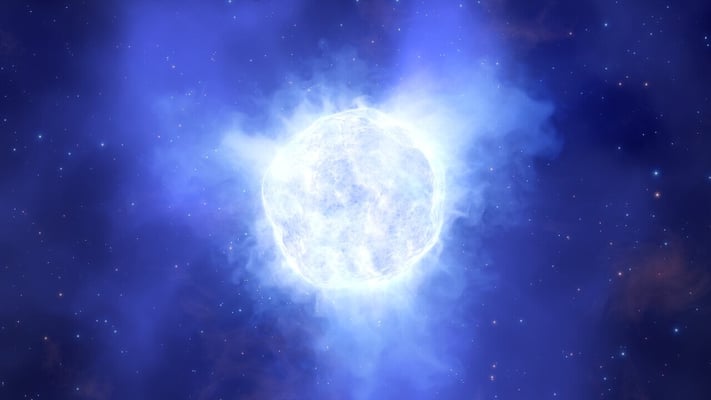A Star Just Collapsed to Form a Black Hole

Artist’s impression of the disappearing star. Image ©: European Southern Observatory
The tremendous energy in the star comes from the fusion reaction in which two atoms of hydrogen combine together, or fuse, to form an atom of helium through the proton-proton chain reaction. By this process, it is believed that heavier elements like metal gold will be formed at the star and eventually they evolve and ran out of fuel. What the star will convert into after they ran out of fuel is for the most part determined by their mass. Some will be a black hole, white dwarf, or neutron star depending on their initial mass.
Earlier in 2020 May, a team of astronomers witnessed a planetary system being born and in June 2020, another team of astronomers captured what we called the death of a star. These events which pave a remarkable road toward space exploration and understanding the contents of the vast universe were captured for the first time in history.
And now again a team of astronomers using the European Southern Observatory’s Very Large Telescope (VLT) discovered an absence of unstable massive star in a dwarf galaxy for which they believe that it has been collapsed to form a black hole. What is more astonishing the team suspect is that the star collapsed into a black hole bypassing an event called a supernova which is believed to be a must happen event before star to form a black hole.
Team leader and PhD student Andrew Allan of Trinity College Dublin, Ireland said, "If true, this would be the first direct detection of such a monster star ending its life in this manner.”
The team investigated earlier suspected very massive star in one of the most metal-poor dwarf galaxies, PHL 293B (Kinman Dwarf galaxy). This is not the first time astronomer tracked down this dwarf galaxy. Various teams of astronomers, between 2001 and 2011, studied the mysterious massive dwarf galaxy and star, located in the constellation of Aquarius, and their observations indicated that the star is already in its late stage of evolution. And in 2019, a new team of astronomers from Chile, USA and Ireland, led by Andrew Allan, wanted to witness more on how very massive stars evolve and end their lives, so they started to track Kinman Dwarf galaxy and the star. When they started to observe they could no longer find the telltale signatures of the star and that disappearance starts bothering them.
The story of detecting the star’s disappearance goes like this; Kinman Dwarf galaxy lies almost 75 million light-years away from Earth so to see it and its individual stars is merely an easy task, however, we can track the signature of some of them. The data of the dwarf galaxy from 2001 to 2011 indicated that the galaxy hosted a luminous blue variable star which is almost 2.5 million times brighter than our Sun. They have then understood that stars of this type are unstable and may show occasional dramatic shifts in their spectra and brightness. However, at last, the luminous blue variable star will leave behind the specific traces scientists can identify. But the trace was absent at the first data that are collected by the team in 2019.
In August 2019, the same group first used Echelle SPectrograph for Rocky Exoplanet and Stable Spectroscopic Observations (ESPRESSO) and VLT’s four 8-metre telescopes simultaneously but could not record any the signs that previously pointed to the presence of the luminous star. So, for the second time, they turned X-shooter - a multi-wavelength (300-2500 nm), medium resolution spectrograph at VLT and they again found no traces of the star.
Then astronomers went through the old collected data using X-shooter and the Ultraviolet and Visual Echelle Spectrograph (UVES) instrument on ESO’s VLT, located in the Chilean Atacama Desert, and telescopes elsewhere. Going through the older data they found that the star in the Kinman Dwarf could have been undergoing a strong outburst period that likely ended sometime after 2011 and this seems explainable too: luminous blue variable stars such as this one are prone to experiencing giant outbursts over the course of their life, causing the stars’ rate of mass loss to spike and their luminosity to increase dramatically.
Read: Telescope (Part-Two); Types of Telescopes for Astronomy
As the traces are absent from the data of 2019 and are available in the older, astronomers wonder what had happened to the star. They concluded that the star must have gone outburst and disappeared instantly. On this Allan said, “It would be highly unusual for such a massive star to disappear without producing a bright supernova explosion.”
There can have two explanations for the star’s disappearance and lack of a supernova. One is; the outburst may have resulted in the luminous blue variable being transformed into a less luminous star, which could also be partly hidden by dust. Another explanation is; star may have collapsed into a black hole, without producing a supernova explosion. This would be a rare event: our current understanding of how massive stars die points to most of them ending their lives in a supernova.
Andrea Mehner, a staff astronomer at ESO in Chile who participated in the study said, “The ESO Science Archive Facility enabled us to find and use data of the same object obtained in 2002 and 2009. The comparison of the 2002 high-resolution UVES spectra with our observations obtained in 2019 with ESO's newest high-resolution spectrograph ESPRESSO was especially revealing, from both an astronomical and an instrumentation point of view.”
The research work was described in the journal Monthly Notices of the Royal Astronomical Society.
